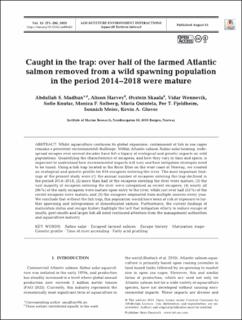| dc.contributor.author | Madhun, Abdullah Sami | |
| dc.contributor.author | Harvey, Alison C. | |
| dc.contributor.author | Skaala, Øystein | |
| dc.contributor.author | Wennevik, Vidar | |
| dc.contributor.author | Knutar, Sofie | |
| dc.contributor.author | Solberg, Monica Favnebøe | |
| dc.contributor.author | Quintela, Maria | |
| dc.contributor.author | Andersen-Fjeldheim, Per Tommy | |
| dc.contributor.author | Meier, Sonnich | |
| dc.contributor.author | Glover, Kevin Alan | |
| dc.date.accessioned | 2023-12-04T09:07:32Z | |
| dc.date.available | 2023-12-04T09:07:32Z | |
| dc.date.created | 2023-11-07T14:53:15Z | |
| dc.date.issued | 2023 | |
| dc.identifier.citation | Aquaculture Environment Interactions. 2023, 15 271-285. | |
| dc.identifier.issn | 1869-215X | |
| dc.identifier.uri | https://hdl.handle.net/11250/3105743 | |
| dc.description.abstract | Whilst aquaculture continues its global expansion, containment of fish in sea cages remains a persistent environmental challenge. Within Atlantic salmon Salmo salar farming, widespread escapes over several decades have left a legacy of ecological and genetic impacts on wild populations. Quantifying the characteristics of escapees, and how they vary in time and space, is important to understand how environmental impacts will vary and how mitigation strategies need to be tuned. Using a fish trap located in the River Etne on the west coast of Norway, we created an ecological and genetic profile for 616 escapees entering the river. The most important findings of the present study were (1) the annual number of escapees entering the trap declined in the period 2014-2018; (2) more than half of the escapees entering the river were mature; (3) the vast majority of escapees entering the river were categorised as recent escapees; (4) nearly all (96%) of the early escapees were mature upon entry to the river, while just over half (55%) of the recent escapees were mature; and (5) the escapees originated from multiple sources every year. We conclude that without the fish trap, this population would have been at risk of exposure to further spawning and introgression of domesticated salmon. Furthermore, the current findings of maturation status and escape history highlight the fact that mitigation efforts to reduce escape of smolts, post-smolts and larger fish all need continued attention from the management authorities and aquaculture industry. | |
| dc.language.iso | eng | |
| dc.title | Caught in the trap: over half of the farmed Atlantic salmon removed from a wild spawning population in the period 2014−2018 were mature | |
| dc.title.alternative | Caught in the trap: over half of the farmed Atlantic salmon removed from a wild spawning population in the period 2014−2018 were mature | |
| dc.type | Peer reviewed | |
| dc.type | Journal article | |
| dc.description.version | publishedVersion | |
| dc.source.pagenumber | 271-285 | |
| dc.source.volume | 15 | |
| dc.source.journal | Aquaculture Environment Interactions | |
| dc.identifier.doi | 10.3354/AEI00465 | |
| dc.identifier.cristin | 2193404 | |
| cristin.ispublished | true | |
| cristin.fulltext | original | |
| cristin.qualitycode | 1 | |
